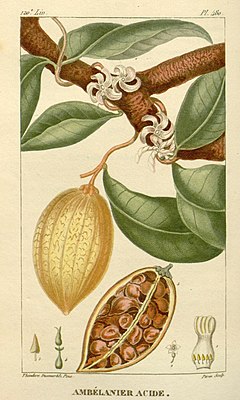Ambelania acida
| Ambelania acida | ||||||||||||
|---|---|---|---|---|---|---|---|---|---|---|---|---|

Illustration of Ambelania acida |
||||||||||||
| Systematics | ||||||||||||
|
||||||||||||
| Scientific name | ||||||||||||
| Ambelania acida | ||||||||||||
| Aubl. |
Ambelania acida is a species of plant in the dog poison familyfrom northern and northeastern Brazil , the Guyanas and from Venezuela to Peru .
description
Ambelania acida grows as a small, evergreen tree to over 8-10 meters high or as a smaller shrub. The trunk diameter reaches up to 20-25 centimeters. The tree has a milky sap . The thick, brownish bark is soft and smooth with lenticels .
The simple, short-stalked and thick-leather, bare leaves are opposite. The rivulet petiole is 1–2 centimeters long and the opposite petioles are sometimes united in a short ochrea . The entire, egg-shaped to obovate or elliptical leaves are 12–24 inches long and up to 8.5 inches wide. At the top they are rounded to pointed or pointed. The veins are finely pinnate, with fine lateral veins that converge intramarginally. The stipules are missing.
The flowers appear in axillary, small, multi-to multi-flowered, short-stalked dichasias with very small bracts and bracts . The white to yellow and five-fold, short-stalked and hermaphrodite flowers have a double flower envelope . The calyx is small and five-lobed. The crown is fused in the shape of a salver plate with protruding and rolled-up, elongated to oblanceolate, up to 10-13 millimeter long tips. There are 5 almost sessile stamens , with arrow-shaped anthers, in the upper, 10-12 millimeters long, narrow and greenish corolla tube. The two-chamber ovary is constantly above, with a short stylus with a small stylus head (Clavuncula) having two scars branches .
8-14 centimeters long and up to 4-6 centimeters thick, many-seeded and mostly ribbed, yellow, slightly brownish spotted, leathery, egg-shaped to narrow-ellipsoidal berries (armored berries ) with calyx remains are formed. The flattened, egg-shaped to elliptical and dark brown seeds are 7-10 millimeters long.
use
The sweet and sour, milky fruits with whitish flesh are edible. They are used raw and cooked, they must be punctured and peeled beforehand to allow the milky juice to drain off. In Brazil the fruit is known as Pepino do Mato .
The milky juice, like the fruits and the bark , is used medicinally.
The wood is only used as fuel.
literature
- James L. Zarruchi: A revision of the tribe Ambelanieae (Apocynaceae - Plumerioideae). Agricultural University Wageningen Papers No. 87-1, 1988, ISBN 90-6754-100-1 , online (PDF; 4.6 MB) at WUR E-depot.
- Food and fruit-bearing forest species. 3: Examples from Latin America , FAO Forestry Paper 44/3, FAO, 1986, ISBN 92-5-102372-7 , p. 11 ff.
- Harri Lorenzi: Árvores Brasileiras. Vol. 2, Instituto Plantarum, 1998, ISBN 85-86714-07-0 , p. 18, online at StuDocu.
- Joachim W. Kadereit , Volker Bittrich: The Families and Genera of Vascular Plants. Vol.XV : Flowering Plants Eudicots , Springer, 2018, ISBN 978-3-319-93605-5 , p. 267.
Web links
- Ambelania acida at Flore de Guyane (pictures).
- Ambelania acida at Useful Tropical Plants.
- Pepino-do-Mato at Frutas Nativas da Amazônia.